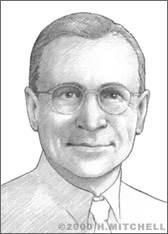Vladimir Zworykin
One of the foremost figures in the complex history of television is Vladimir Zworykin (1889-1982), who invented the “iconoscope,” “kinemascope,” and “storage principle” that became the basis of TV as we know it.
Born in 1889 in Murom, Russia, 200 miles east of Moscow, Vladimir Kosma Zworykin began his career in electrical engineering at the age of nine, repairing equipment on his father’s riverboats. His formal career began at the Imperial Institute of Technology in St. Petersburg (1908), where he had the good fortune to work with Boris Rosing, the director of the school’s labs.
The idea of sending images by wire had been tantalizing scientists since 1839. The earliest mechanical television systems, like the one patented by the German Paul Nipkow in 1884, projected light onto a light-sensitive area through a series of holes cut near the rim of a spinning disc. In 1897, another German, Karl Braun, invented the cathode ray oscilloscope, in which magnetic fields directed the rays onto a fluorescent material at the end of a tube. By the time Zworykin graduated with honors in Electrical Engineering (1912), he had assisted Rosing in developing (1907) and exhibiting (1910) a primitive but successful hybrid television system that used the mechanical Nipkow disc as a camera and Braun’s electronic cathode ray tube as a receiver.
The incipient Russian Revolution soon interrupted further improvements to the pair’s system. Rosing went into exile and died. Zworykin made his way to Paris (1912), where he did work in x-rays and theoretical physics before immigrating to the U.S. (1919). For ten years, he worked at Westinghouse’s labs in Pittsburgh. In 1923, Zworykin won his first television system patent; but his superiors at Westinghouse told him to stop wasting his time on such impractical pursuits. Zworykin continued his television work on his own time, and produced both the “kinescope,” a more sophisticated cathode-ray picture tube, and the “iconoscope,” the first all-electronic camera tube.
He demonstrated his all-electronic system at a convention of radio engineers in 1929. In attendance was David Sarnoff, an RCA executive who since the early 1920s had been predicting that “every farmhouse” would soon have a television. Hearing from Zworykin that he would need $100,000 and 18 months to produce a marketable television, Sarnoff recruited him on the spot, to be Director of RCA’s Electronic Research Lab in Camden, New Jersey.
In the event, it took Zworykin and RCA $50 million and ten years. Meanwhile, companies the world over were developing cathode-ray-based television. The most formidable competitor was Philo Farnsworth, whose 1930 patent for an all-electronic TV would force RCA to pay $1 million in licensing fees in the 1940s. But by that time, Zworykin’s system had won the race to the public. RCA introduced television to the masses at the World’s Fair in New York City in 1939; in fact, the newly formed National Broadcasting Company (NBC) telecast the Fair’s opening ceremonies, with President Franklin D. Roosevelt presiding, locally ten days later.
The Second World War (1939-45) effectively halted the spread of television: in 1946, there were only about 7,000 TV sets in American homes. By 1950, however, there were 10,000,000; and most of them, whether manufactured by RCA or others, used the same basic technology as Vladimir Zworykin’s 1939 model.
Zworykin passed away on July 29, 1982 in Princeton, NJ at 92 years old.


